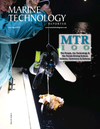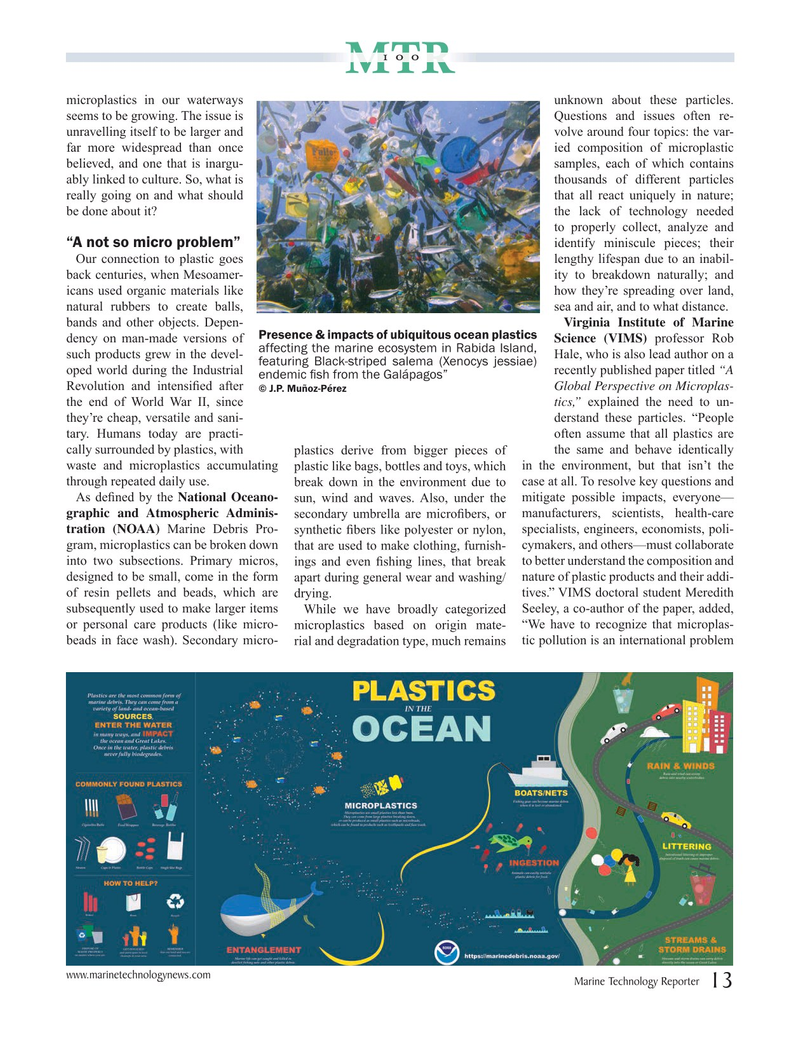
Page 13: of Marine Technology Magazine (July 2020)
Read this page in Pdf, Flash or Html5 edition of July 2020 Marine Technology Magazine
100
MTRMTR microplastics in our waterways unknown about these particles. seems to be growing. The issue is Questions and issues often re- unravelling itself to be larger and volve around four topics: the var- far more widespread than once ied composition of microplastic believed, and one that is inargu- samples, each of which contains ably linked to culture. So, what is thousands of different particles really going on and what should that all react uniquely in nature; be done about it? the lack of technology needed to properly collect, analyze and “A not so micro problem” identify miniscule pieces; their
Our connection to plastic goes lengthy lifespan due to an inabil- back centuries, when Mesoamer- ity to breakdown naturally; and icans used organic materials like how they’re spreading over land, natural rubbers to create balls, sea and air, and to what distance. bands and other objects. Depen- Virginia Institute of Marine dency on man-made versions of Presence & impacts of ubiquitous ocean plastics
Science (VIMS) professor Rob affecting the marine ecosystem in Rabida Island, such products grew in the devel- Hale, who is also lead author on a featuring Black-striped salema (Xenocys jessiae) oped world during the Industrial endemic ? sh from the Galápagos” recently published paper titled “A
Revolution and intensi? ed after Global Perspective on Microplas- © J.P. Muñoz-Pérez the end of World War II, since tics,” explained the need to un- they’re cheap, versatile and sani- derstand these particles. “People tary. Humans today are practi- often assume that all plastics are cally surrounded by plastics, with plastics derive from bigger pieces of the same and behave identically waste and microplastics accumulating plastic like bags, bottles and toys, which in the environment, but that isn’t the through repeated daily use. break down in the environment due to case at all. To resolve key questions and
As de? ned by the National Oceano- sun, wind and waves. Also, under the mitigate possible impacts, everyone— graphic and Atmospheric Adminis- secondary umbrella are micro? bers, or manufacturers, scientists, health-care tration (NOAA) Marine Debris Pro- synthetic ? bers like polyester or nylon, specialists, engineers, economists, poli- gram, microplastics can be broken down that are used to make clothing, furnish- cymakers, and others—must collaborate into two subsections. Primary micros, ings and even ? shing lines, that break to better understand the composition and designed to be small, come in the form apart during general wear and washing/ nature of plastic products and their addi- of resin pellets and beads, which are drying. tives.” VIMS doctoral student Meredith subsequently used to make larger items While we have broadly categorized Seeley, a co-author of the paper, added, or personal care products (like micro- microplastics based on origin mate- “We have to recognize that microplas- beads in face wash). Secondary micro- rial and degradation type, much remains tic pollution is an international problem www.marinetechnologynews.com
Marine Technology Reporter 13
MTR #6 (1-17).indd 13 8/12/2020 3:11:12 PM

 12
12

 14
14
